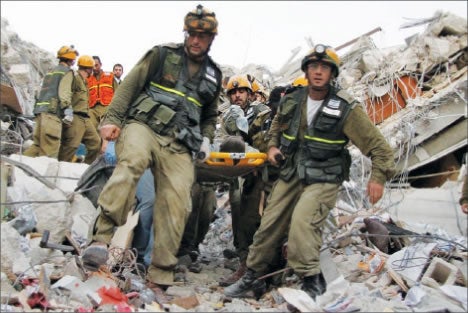Search & Rescue, Part 1
Bob McNally 05.26.15

New York’s Genelle Guzman believed she was going to die.
Trapped for over 24 hours after surviving the collapse of Tower Two of the World Trade Center (WTC) following the Sept. 11 terrorist-hijacked airplane attack, Guzman, then age 32, was engulfed in darkness and she could hear no noise of rescuers she hoped would come to her aid. She was badly injured, trapped, alone, and losing hope of rescue.
Guzman worked for the New York Port Authority on the 64th floor of Tower Two. She and over a dozen other co-workers were advised to stay in their offices when the initial terrorist plane struck the first WTC tower. But Guzman and her colleagues decided to evacuate the building when the second plane struck the tower in which she worked. She, a close friend and thousands of other people walked down emergency stairs toward the ground.
But Guzman, her friend, and many others didn’t make it out before the building collapsed around them. She remembers holding her friend’s hand, huddled in a stairwell corner, as the building came crashing thunderously down in an avalanche of debris, dust, concrete and steel.
Miraculously, Guzman survived the building collapse. But her legs were severely injured, and she was stuck under a pile of rubble, her head trapped between two immense cement pilings. She lost her friend forever in a cascade of tons of WTC debris.
“I’m going to die here,” she thought to herself in despair. “I am going to see myself slowly die here,”
As the minutes, and then hours, ticked slowly away, Guzman watched day turn into darkness. Her hope for survival and rescue waned as the long, gloomy night dragged on. She prayed, asking God for a miracle.
“Show me a sign that I am going to get out of here,” she remembers praying.
Roughly 27 hours after the building collapsed, Guzman heard noises, sounds she thought, she hoped, were rescuers searching for survivors. She shouted as loud as her weakened body allowed to draw attention to herself. The searchers returned her cry. Frantic to make more distinct sounds to aid rescuers in pinpointing her, Guzman used pieces of concrete to smash loudly against one another.
Firemen searching the rubble heard the concrete banging sounds and Guzman’s cries for help. They yelled back, and scanned the area with flashlight beams to find and reassure her that help was on the way.
She kept clanking concrete chunks loudly, which aided firemen in finding her. As she heard the rescuers getting closer Guzman wiggled one of her hands up through the rubble, toward the light and sounds of rescue aid. One of the fireman saw her moving hand, then heard her cries.
“I’ve got you,” he said as he clutched her outstretched fingers.
“Thank God,” she replied, relieved her terrorist-caused, survival ordeal was nearly over.
Genelle Guzman was the last person rescued from the WTC building collapse, only the fifth survivor pulled from the wreckage created by airplane terrorists. She endured 27 horrifying hours pinned painfully in a hodgepodge of twisted rubble. After a hospital stay and extensive rehabilitation, her life slowly return to near normal.
Guzman’s survival is miraculous by any measure, but there are things to learn from her ordeal, lessons that can aid others who may one day be in a similar predicament.
“It sounds crazy—truly bizarre and strange—to talk about this in America, but with the terrorist threat all too real, it makes sense for everyone to be prepared for calamities like the Oklahoma City Federal Building bombing and the World Trade Center attacks,” says Les McCormick, a Jacksonville, Florida Fire Department captain, and member of the city’s special operations training cadre’–an elite team that trains specifically for such disasters. “We’re in an era now when urban survival training is important. It’s a life or death scenario, and people who are prepared to survive a terrorist attack will have a better chance of staying alive than civilians who do not.
“Victims can make it a lot easier for rescuers to locate them if they have a few helpful items with them. It’s sort of like the Boy Scout motto of ‘Be Prepared.’ It’s a shame that’s the way it is today in the United States. But that’s the way it’s going to be for some time, I’m afraid. Citizens should adopt the frontiersmen mentality of 100 years ago. If the pioneers needed something for survival, they made sure they had it with them at all times. And I mean all the time.”
McCormick says a standard police-type whistle is a simple piece of survival equipment easily carried by almost anyone that can quickly alert rescuers to the location of a trapped person. A shrill-sounding whistle would have made Genelle Guzman much easier to locate in the WTC rubble. While almost any whistle can be helpful, McCormick favors loud, never-fail Coast Guard-approved whistles. They are not bulky and easily can be put on a key chain and left in a pants pocket. They also can be worn unobtrusively on a lanyard around the neck, placed under a blouse, or even under a work shirt with coat and tie.
It takes time for rescue procedures to get underway at a large disaster site. To pull injured and trapped people out of isolated areas not obliterated in an initial disaster is not a simple procedure. This is especially true in the case of a large, multi-floor building like the WTC and the Oklahoma City Federal Building. So the longer a person in a disaster can survive on his own, the better the odds for his ultimate rescue.